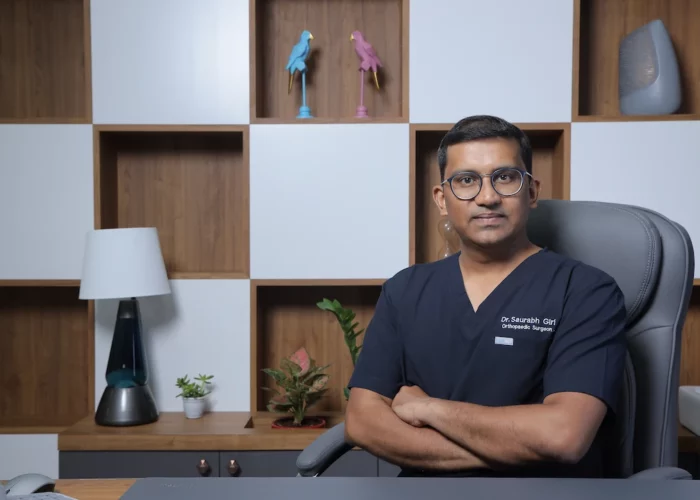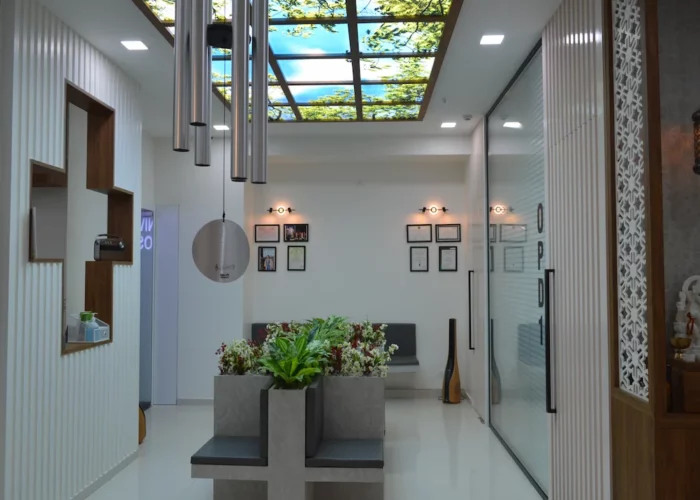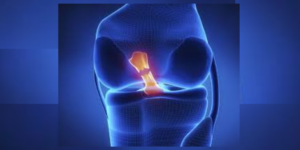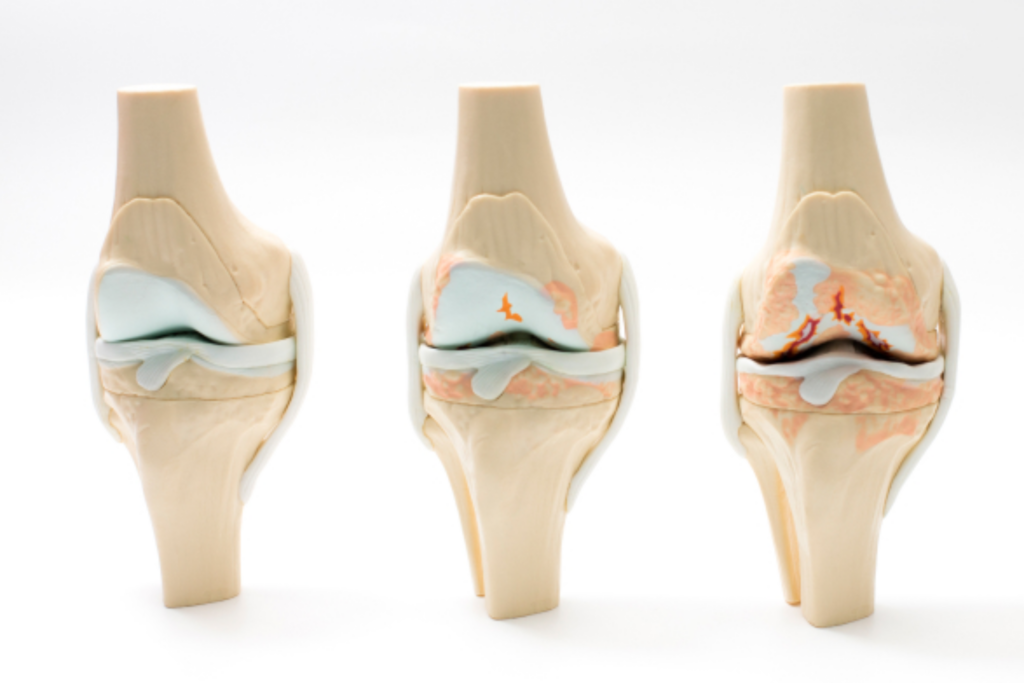ACL surgery is a procedure in which arthroscopy is used to replace a torn ligament in your knee.
Did You Know?
7 out of 10 Anterior Cruciate Ligament (ACL) tears can heal without surgery! And if surgery is required, you can return to sports and running within just three months after undergoing advanced ACL surgery by Dr. Saurabh Giri at Helios Orthojoint Clinic, Pune.
Best ACL Repair & Reconstruction Surgery
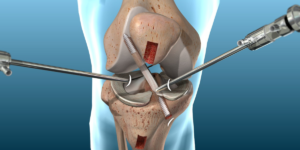
Are you experiencing any of the following?
✅ Instability, pain, loss of confidence, locking, or clicking in your knee?
✅ Difficulty enjoying daily activities like running, dancing, trekking, or sports?
✅ Weight gain due to limited physical activity caused by knee issues
Don’t rush into treatment without understanding these important facts about ACL injuries!
We offer proven methods to help you return to running and sports within 3 months after an ACL injury, even if you’re currently experiencing instability, pain, or knee locking.
Your Solution Starts Here!
Dr. Saurabh Giri will evaluate your condition based on MRI scans and a detailed knee examination to determine the best treatment plan for your injury.
1) Percutaneous ACL Repair – Non-Surgical Healing
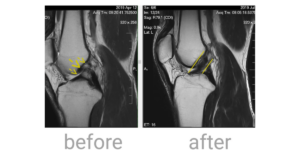
✅ 70% of ACL tears can heal without surgery. Our goal is to preserve your ACL, not replace it.
✅ This procedure is ideal for partial or complete non-retracted ACL tears.
✅ Using orthobiologics treatments, we stimulate natural healing by utilizing your body’s own regenerative capabilities, eliminating the need for surgery.
2) QuadPro ACL Reconstruction – Cutting-Edge Technology
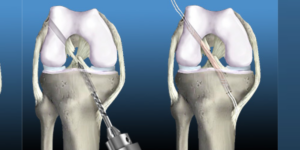
Faster Recovery with a Quadriceps Tendon Autograft
We utilize the Quadriceps Tendon Graft, which offers:
✅ Faster recovery with a minimally invasive approach.
✅ Stronger and more reliable outcomes compared to hamstring or patellar grafts.
✅ Lower risk of revision surgeries, ensuring long-term stability.
Why is QuadPro superior?
✔ Quick Recovery: Resume activity faster due to its minimally invasive nature.
✔ Less Trauma & Pain: Reduces surgical trauma, ensuring a smooth healing process.
✔ Lower Re-Tear Rate: Research shows significantly reduced failure rates.
Innovative Internal Brace Technology
Studies show an 88% reduction in ACL re-injury rates with Internal Brace reconstruction. This approach enhances stability, proprioception, and long-term knee health.
Faster Return to Sports & Activity:
✅ Pain-free walking & 100-degree knee bending in just ONE DAY post-surgery!
✅ Resume squats & lunges within a week.
✅ Jogging starts after 1 month instead of 3 months.
✅ Back to sports & running in just 3 months!
Ready to Get Back to Sports Faster & Stronger?
Follow These Simple Steps:
Step 1: WhatsApp your MRI to +91 9156580303.
Step 2: Get a free online consultation.
Step 3: Fix an appointment with Dr. Saurabh Giri.
Step 4: Confirm the diagnosis & treatment plan.
Step 5: Get your ACL repaired.
Step 6: Get back to sports & running in just 3 months!
3) ACL Repair with Fiber Tape Internal Brace
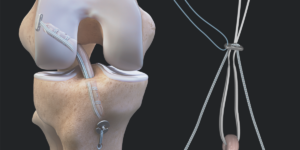
Unlike traditional ACL reconstruction that removes damaged tissue, we use a Fiber Tape Internal Brace to repair and protect your ACL during healing.
✅ Preserves original ACL tissue & proprioception nerve endings for superior stability.
✅ Faster recovery & less pain compared to conventional ACL reconstruction.
✅ Athletes regain full confidence in their knee and return to sports within 3 months.
4) Anterolateral Ligament (ALL) Internal Brace
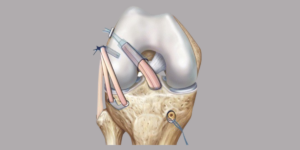
Many ACL injuries also involve damage to the Anterolateral Ligament (ALL), which, if left untreated, can increase the risk of ACL re-tears.
✅ Minimally invasive technique to reinforce the ACL repair.
✅ Improves stability and reduces stress on the reconstructed ACL.
✅ Reduces the risk of re-injury & surgical failure.
5) ACL Avulsion Repair – Preserving Your Natural ACL
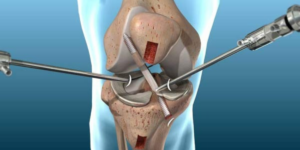
Arthroscopic, minimally invasive ACL avulsion repair is the best solution for ACL avulsions with tibial spine fractures.
✅ Preserves your original ACL instead of reconstructing it.
✅ Uses Fiber Tape Internal Brace & Tightrope RT for early mobilization.
✅ Return to running & sports within 3 months!
Why Choose Helios Orthojoint Clinic, Pune?
✔ Advanced ACL treatments with cutting-edge techniques.
✔ Faster recovery & minimal downtime.
✔ Experienced & specialized knee surgeon – Dr. Saurabh Giri.
✔ Customized treatment plans for each patient.
Get started today! WhatsApp your MRI to +91 9156580303 and take the first step toward a pain-free, active life!
Click to see our Patients’ results:
- Google Reviews: Patient Stories on Google Reviews
- Patient Story Videos: Patient Stories on YouTube
What happens if you don’t take any treatment for your ACL injury?
Partial ACL Tear (Grade 1 & 2 Sprain):
If treatment is delayed, a partial ACL tear can progress to a complete tear, eliminating the possibility of healing without surgery. Eventually, surgical intervention such as arthroscopic all-inside ACL reconstruction with fiber tape internal brace will be required.
Complete ACL Tear (Grade 3, Near Complete Tear):
Delaying treatment for months can lead to knee cartilage damage, meniscus injuries, and muscle degeneration. A torn ACL accelerates knee degeneration, leading to secondary osteoarthritis at an early stage, which may require total knee replacement surgery. Timely treatment is essential to prevent osteoarthritis, maintain an active lifestyle, and avoid knee replacement.
With all-inside anterior cruciate ligament reconstruction using fiber tape internal brace, patients can resume running and sports within three months of surgery.
What is the average cost of ACL reconstruction/repair in India?
All-Inside ACL Reconstruction with Fiber Tape Internal Brace
- The cost of ACL surgery varies based on hospital quality, healthcare facilities, surgical techniques, implant quality, and doctor expertise.
- India is one of the best countries for advanced ACL reconstruction at a significantly lower cost compared to European and American hospitals.
- Indian doctors are highly skilled, and more than 5 million ACL/PCL reconstructions are performed annually in India.
- The package cost of all-inside anterior cruciate ligament (ACL) reconstruction with fiber tape internal brace (implant sourced from India) ranges from INR 1,60,000 to INR 3,00,000, depending on hospital room category and implant quality.
- Saurabh Giri at Helios Orthojoint Clinic, Pune, has a 100% recovery rate using fiber tape internal brace arthroscopically. This advanced procedure offers superior outcomes compared to the traditional bio screw method.
- With fiber tape internal brace ACL reconstruction, patients can start jogging within one month and return to sports/running in three months.
- The bio screw technique is more affordable due to the lower implant cost, but fiber tape internal brace offers better results and faster recovery.
- Additional costs include rehabilitation and treatment of associated knee injuries like meniscus, PCL, MCL, and LCL injuries. No ACL surgery guarantees the best recovery without physical therapy, which is not included in the surgery cost.
What is ACL?
ACL (Anterior Cruciate Ligament) is a ligament deep within the knee joint, essential for knee stability. The knee joint consists of three primary bones: the femur, tibia, and patella. Various structures, including ligaments, muscles, cartilage, and bursae, support the knee’s function.
The ACL, composed of Type 1 collagen, connects the femur and tibia, providing protection and stability throughout knee movement. It consists of two bundles:
- Anteromedial Bundle (tightens during knee bending)
- Posterolateral Bundle (tightens when the knee is extended)
The ACL also stabilizes the knee during rotation. ACL injuries are common in athletes but can also occur in non-athletic activities due to sudden movements.
Why is the ACL commonly injured?
Since the ACL is located at the center of the knee joint, it is highly prone to injury due to twisting movements or direct impact.
Non-Contact ACL Injuries (Most Common):
- Sudden changes in direction while running.
- Pivoting, jumping, or landing awkwardly.
- Twisting the hip while transferring weight.
Contact ACL Injuries:
- Occurs due to direct impact or a blow to the knee.
- Often associated with damage to other knee structures due to external force.
Symptoms of an ACL Injury
Many patients describe their injury as:
- “I planted my foot, my knee twisted, I heard a pop sound, and I couldn’t continue playing.”
- “At first, I could walk, but my knee later became swollen and painful.”
- “When I walk on uneven surfaces, my knee feels unstable or gives way.”
Common Symptoms:
- Sharp pain, often preventing movement.
- Swelling (immediate or within 24 hours, lasting up to a week).
- Instability, especially while running, walking on slopes, or on uneven ground.
- Laxity in the knee joint.
- Shin bone feels like it’s moving forward excessively.
- Painful weight-bearing.
Types of ACL Injuries (Grades 1-3)
- Grade 1: ACL fibers are stretched but not torn; the knee remains stable.
- Grade 2: Partial ACL tear with ligament fibers damaged; stability is compromised. Surgery is recommended for poor prognosis.
- Grade 3: Complete ACL tear; the ligament is fully torn into two parts. This is the most common ACL injury requiring surgery.
How to Diagnose an ACL Tear?
Physical Tests:
- Anterior Drawer Test – Checking for excessive tibial movement.
- Lachman Test – Evaluating knee stability by anterior tibial translation.
- Pivot Shift Test – Observing tibial subluxation during movement.
Confirm Diagnosis with MRI and Physical Assessment.
ACL Injury Treatment: Surgical vs. Non-Surgical
The best treatment plan depends on MRI findings and physical examination. ACL injuries often occur alongside other knee injuries (meniscus, PCL, MCL), influencing treatment decisions.
Prevention of ACL Injuries
Women are more prone to ACL injuries due to anatomical and hormonal factors:
- Wider pelvis
- Increased Q-angle
- Smaller ACL size and intercondylar notch width
- Hormonal influences (pre-ovulatory phase)
Reducing ACL Injury Risk:
- Strength training (quadriceps, hamstrings)
- Neuromuscular training
- Proper gait correction & agility drills
- Plyometric training (jumping exercises)
For expert ACL treatment, consult Dr. Saurabh Giri at Helios Orthojoint Clinic, Pune. Our advanced fiber tape internal brace technique ensures a quick recovery and return to sports.
FAQ's
ACL Tear
What is the ACL?
The anterior cruciate ligament (ACL) is located in the center of the knee and functions as the primary stabilizer of the joint. It is a strong ligament that connects the femur (thigh bone) to the tibia (shinbone), preventing the tibia from moving forward relative to the femur. The ACL allows smooth, pain-free movement of the knee while maintaining stability.
How does an ACL injury occur?
An ACL tear is one of the most common ligament injuries in the knee. It can occur due to non-contact trauma or a direct impact on the leg. Some specific movements that increase the risk of ACL injury include jumping and landing incorrectly, pivoting and cutting motions, and sudden twisting or turning of the knee.
What age group is most affected by ACL tears?
Studies indicate that ACL injuries are most common among males aged 19 to 25 years and females aged 14 to 18 years.
Are ACL injuries more common in females?
Yes, female athletes have an eight times higher risk of ACL injury compared to males. This is attributed to differences in leg alignment and increased tissue elasticity.
What are the signs and symptoms of an ACL tear?
A loud “pop” sound may be heard at the time of injury, followed by knee pain and swelling. Individuals may experience instability while walking or running, along with sensations of knee “giving way.” Other possible symptoms include knee locking and clicking.
What should I do if I suspect an ACL injury?
If you suspect an ACL injury, immediately stop physical activities and follow the PRICE method: Protection, Rest, Ice application, Compression, and Elevation. Seek medical evaluation as soon as possible for further diagnosis and treatment.
How is an ACL tear diagnosed?
A physician will conduct a thorough physical examination, including tests such as the Lachman test, anterior drawer test, and pivot shift test. Additional imaging, like X-rays and MRI scans, may be required to assess associated injuries.
Can an ACL tear heal without surgery?
Partial tears (Grade 1) or ligament sprains can heal with conservative treatments like orthobiologics. However, complete ACL tears (Grade 3) usually require surgical intervention.
What are the treatment options for ACL injuries?
- Grade 1 or 2 ACL injuries: Treated non-surgically with orthobiologics and rehabilitation.
- Grade 3 ACL injuries (Complete Tear): Require arthroscopic ACL reconstruction using a graft from the patient’s hamstring tendon.
Advanced surgical techniques: All-inside ACL reconstruction with a fiber tape internal brace enables faster recovery. Patients can walk pain-free the next day, bend the knee up to 90 degrees without pain, start jogging within a month, and return to sports in three months
Can ACL reconstruction be performed in children?
Yes, with modern techniques, ACL reconstruction can be done without affecting the growth plate. If the injury is diagnosed early, ACL repair may be an option instead of reconstruction.
Is ACL surgery worth it?
Yes. A torn ACL leads to knee instability, making activities like running and sports difficult. Delaying surgery increases the risk of knee cartilage and meniscus degeneration, leading to early osteoarthritis.
How painful is ACL surgery?
Pain levels vary depending on the surgical technique:
- Traditional bio-screw technique: More postoperative pain, with complete knee bending taking about two months.
- All-inside ACL reconstruction with fiber tape internal brace: Minimal pain, with the ability to bend the knee up to 100 degrees the day after surgery and walk without support.
How long is recovery after ACL surgery?
- All-inside ACL reconstruction with fiber tape internal brace: Jogging in one month, sports in three months.
Bio-screw fixation: Running and sports after six to seven months, with a higher failure rate.
Are screws used in ACL surgery?
Yes, most surgeries use either bio screws or titanium screws. However, the all-inside ACL reconstruction with fiber tape internal brace provides stronger fixation and faster recovery without using screws.
How long will I need crutches after ACL surgery?
- All-inside ACL reconstruction with fiber tape internal brace: No crutches needed; patients walk pain-free the next day.
- Bio-screw fixation: Crutches are required for two to three weeks.
How soon can I return to work after ACL surgery?
- All-inside ACL reconstruction with fiber tape internal brace: 7 to 10 days.
- Traditional bio-screw fixation: 45 to 60 days.
How long does ACL surgery take?
Approximately 30 to 45 minutes.
Is it bad to delay ACL surgery?
Yes, delaying ACL surgery increases the risk of knee degeneration, meniscus damage, and osteoarthritis. Ideally, surgery should be done within a few weeks after injury.
Can you walk with a torn ACL?
While walking may be possible after the initial swelling subsides, running and sports activities will be difficult due to instability.
How serious is a torn ACL?
If untreated, a torn ACL can lead to knee instability, degeneration, and early osteoarthritis, eventually requiring total knee replacement.
Can ACL surgery fail?
Failure can occur due to improper surgical technique, graft loosening, or inadequate rehabilitation. Traditional bio-screw surgery has a 30% failure rate, while all-inside ACL reconstruction with fiber tape internal brace has significantly lower failure rates.
How successful is ACL surgery?
- All-inside ACL reconstruction with fiber tape internal brace: 99% success rate, with return to sports in three months.
- Bio-screw technique: 70% success rate, requiring longer rehabilitation.
What is the cost of ACL surgery?
The cost of arthroscopic all-inside ACL reconstruction with fiber tape internal brace in India ranges from ₹1.7 lakh to ₹3.5 lakh, depending on the implant and hospital category.
Can an ACL tear heal naturally?
Partial tears (Grade 1) can heal with orthobiologic treatments, but complete tears typically require surgery.
How can I prevent ACL injuries?
Strength training, balance exercises, proprioception drills, and functional movement training can reduce the risk of ACL injuries.
Need expert care for a knee injury?
If you are suffering from knee pain or limited mobility due to an ACL injury, contact Dr. Saurabh Giri at Helios Orthojoint Clinic, Pune for a consultation. The clinic accepts multiple insurance plans for patient convenience.
What people are saying about our services and treatments
Read what our patients have to say. Thank you for your trust and support!
Blogs
Contact Us
Find frequently asked questions and
important information about us
How to book an appointment?
Call our clinic at +91 9156580303. Make an appointment time that works for you. Come prepared and bring with you important documents. Come early to your appointment.
What is waiting period for general checkup?
In normal days there is no such waiting period for general checkups. If there are some operations so that there are waiting period of maximum 30 minutes and for emergency there are no waiting period.
Is there any online appointment form?
No, there is no need to fill out any kind of online appointment form. But, you can book an online appointment through platforms like our website, practo or you can directly call us.
